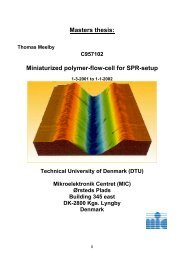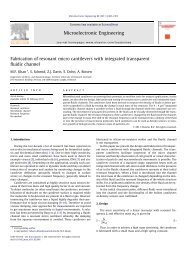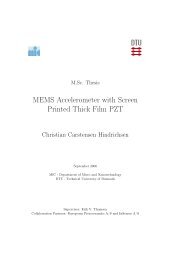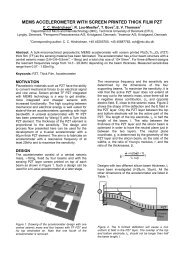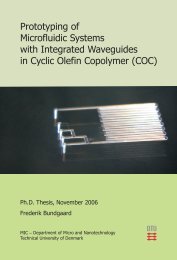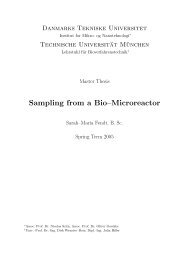Development of a Oxygen Sensor for Marine ... - DTU Nanotech
Development of a Oxygen Sensor for Marine ... - DTU Nanotech
Development of a Oxygen Sensor for Marine ... - DTU Nanotech
You also want an ePaper? Increase the reach of your titles
YUMPU automatically turns print PDFs into web optimized ePapers that Google loves.
Chapter 3<br />
Theory <strong>of</strong> the Clark <strong>Sensor</strong><br />
The Clark sensor was named after its creator Leland C. Clark[21], who in<br />
the late fifties and mid sixties studied the electrochemistry <strong>of</strong> oxygen gas<br />
reduction at platinum (Pt) metal electrodes. Clark began pioneering the<br />
use <strong>of</strong> what would later be an oxygen- (and there<strong>for</strong>e chemical-) sensor. In<br />
fact, Pt electrodes used to detect oxygen electrochemically are <strong>of</strong>ten referred<br />
to generically as ’Clark electrodes’. While the sensor he originally came up<br />
with was intended <strong>for</strong> the measurement <strong>of</strong> glucose concentration in blood,<br />
the sensor itself was the start <strong>of</strong> biosensor history, and the Clark sensor is<br />
still around today with many different shapes and several applications far<br />
from the original design.<br />
Liquid measured<br />
on (Blood, water,<br />
etc.)<br />
Membrane<br />
Ag Wire<br />
Pt<br />
KCl Solution (electrolyte)<br />
Figure 3.1: Sketch <strong>of</strong> a basic 2 electrode Clark <strong>Oxygen</strong> <strong>Sensor</strong>, with a Ag<br />
reference electrode (the anode) and a Pt working electrode (the<br />
cathode).<br />
The electrodes as seen in figure 3.1 have a thin organic membrane covering<br />
a layer <strong>of</strong> electrolyte and two metallic electrodes. <strong>Oxygen</strong> diffuses through<br />
13<br />
A<br />
V



